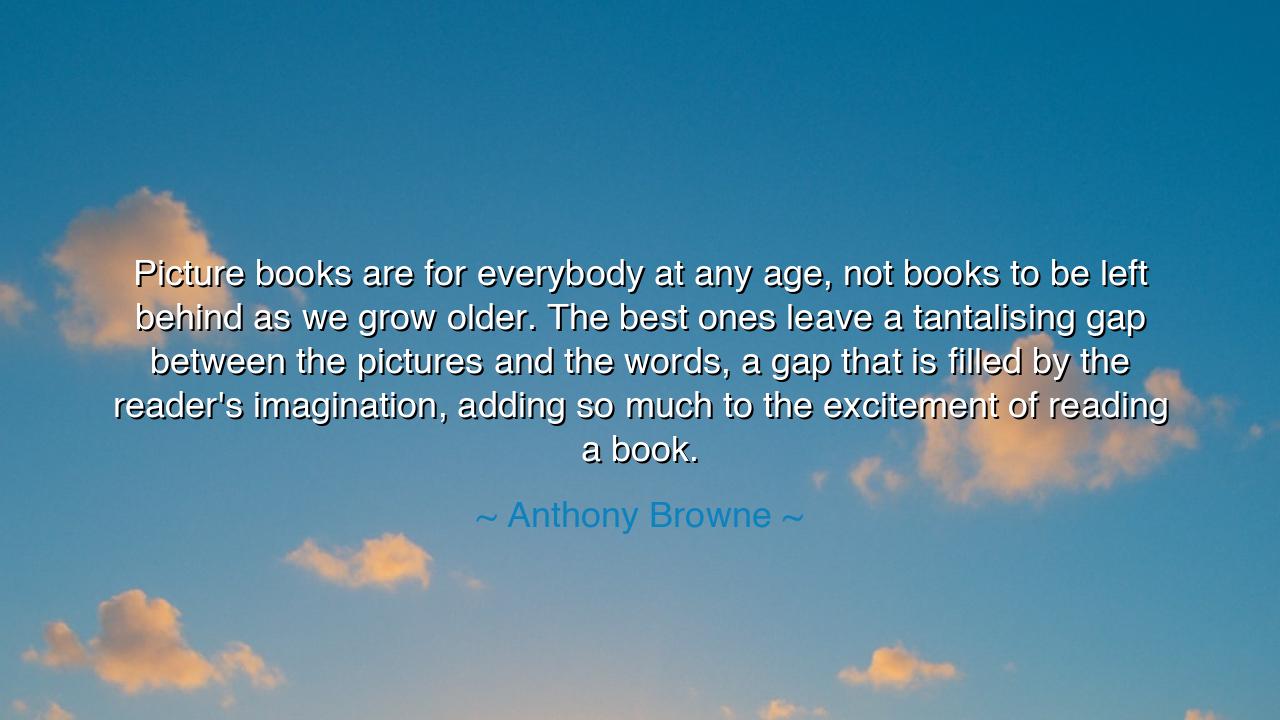
Picture books are for everybody at any age, not books to be left
Picture books are for everybody at any age, not books to be left behind as we grow older. The best ones leave a tantalising gap between the pictures and the words, a gap that is filled by the reader's imagination, adding so much to the excitement of reading a book.






When Anthony Browne said, “Picture books are for everybody at any age, not books to be left behind as we grow older. The best ones leave a tantalising gap between the pictures and the words, a gap that is filled by the reader's imagination, adding so much to the excitement of reading a book,” he spoke as a sage of stories and a guardian of wonder. His words are a gentle yet powerful reminder that imagination does not belong only to childhood, and that picture books, far from being relics of youth, are sacred vessels of human creativity—bridges between sight and spirit, image and idea. In them, he saw a profound truth: that meaning is not given, but co-created, born in the mysterious space between what is seen and what is felt.
The picture book, to Browne, is not a child’s toy, but a mirror of the soul. Its simplicity conceals a depth that can stir even the most hardened of hearts. For in every image there lies a whisper of the infinite, and in every word, a seed of interpretation. The gap between the words and the pictures—that space he calls “tantalising”—is not emptiness, but invitation. It calls the reader to enter, to imagine, to complete the story. It is there, in that sacred interval, that reading becomes not a passive act, but a form of creation. To engage with such a book is to awaken the divine within oneself—the power to see beyond what is shown, to dream beyond what is written.
From the beginning of civilization, humankind has sought to merge image and story. The cave paintings of Lascaux were picture books of their age, the myths of the hunt and the heart painted upon stone, speaking to both eye and soul. The ancients knew that the image has a power words cannot hold alone—it touches the spirit before the mind has time to reason. Centuries later, the illuminated manuscripts of the monks carried this tradition forward: sacred texts adorned with color and light, revealing truths that no word could fully capture. So when Browne speaks, he stands in this long lineage of storytellers who knew that pictures and words together are the twin wings of understanding.
Consider the example of Maurice Sendak, the author of Where the Wild Things Are. His story is small in words but vast in emotion. Between each phrase and each image lies a world that the reader must imagine for themselves. Why does Max long to sail away? What does the forest represent? Each reader’s heart answers differently. And it is in that difference that the book becomes alive. The child sees adventure; the adult sees longing, rebellion, forgiveness. The same pages yield new meanings with age, proving Browne’s wisdom: that picture books are not to be outgrown, but rediscovered again and again, as our own souls change.
Browne’s insight is also a rebuke to a world that worships complexity and forgets wonder. We are taught that to grow older is to leave simplicity behind, to trade curiosity for logic, imagination for efficiency. But the ancients would call this folly. For the wise know that true knowledge does not destroy wonder—it deepens it. The picture book, in its humble form, invites even the scholar to kneel again before mystery. It reminds us that the highest truths can be spoken in the language of the heart, not the tongue of intellect. To see with a child’s eyes is not regression—it is enlightenment.
And so, Browne’s “tantalising gap” becomes more than a feature of storytelling—it becomes a philosophy of life. Between what we know and what we imagine lies the realm of possibility. Between what is written and what is dreamed, life itself unfolds. To live well is to dwell in that gap—to interpret the world not only by sight, but by wonder, not only by knowledge, but by the fire of imagination. The universe itself, like a great picture book, shows us symbols and signs, and leaves to us the sacred task of finding meaning in their arrangement.
Let this then be your lesson: never abandon imagination, no matter your age or station. Return often to the stories that first awakened your heart. Seek not only what the words say, but what the silence between them reveals. When you look upon an image—whether painted by a child or formed by the stars—ask what it means to you, and let that meaning grow. For as Browne teaches, the joy of reading, and indeed of living, comes not from what is given, but from what we dare to imagine in the spaces between.
Thus, let the picture book stand as a symbol of the eternal dialogue between art and soul, word and wonder, mind and imagination. For those who read with both eye and heart shall never grow old; they will forever walk the bright fields of creation, filling the spaces between the seen and the unseen with the light of their own vision. And in that act—quiet, profound, and holy—they will rediscover what it means to be truly human.






AAdministratorAdministrator
Welcome, honored guests. Please leave a comment, we will respond soon